
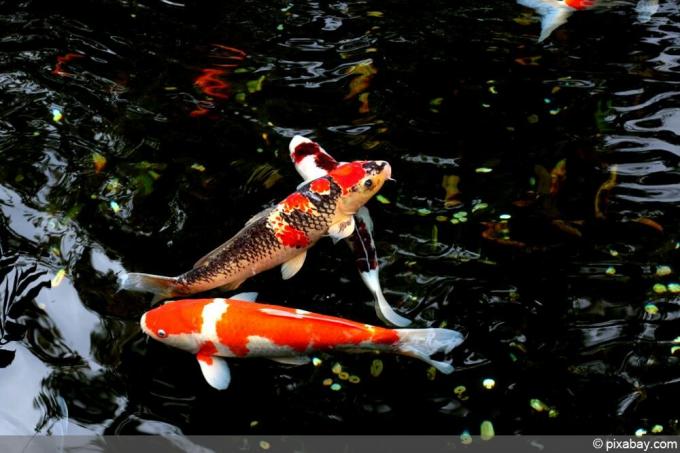
Table of contents
- Garden ponds age quickly
- Why calculating the pond volume is so important
- The larger the pond volume, the more stable the ecological balance
- How much space do fish need in the garden pond?
- Many fish are school animals
- Formula for calculating the fish stock
- How to calculate the pond volume
- Calculate pond volume of irregular ponds
- Other factors that influence the pond volume
- Formula for round ponds
A well-maintained garden pond is an oasis of calm and relaxation. Here you can sit comfortably on the shore and observe nature: how the koi carp and goldfish curiously come to the surface swim as the pond frog sits on the lily pad and catches flies whizzing by or a dragonfly across the surface buzzes. In order for animals and plants to feel comfortable, however, the pond volume must be calculated correctly.
Garden ponds age quickly
Calculating the size of the pond is important for a number of reasons, and not just if you plan to put fish in it. All garden ponds - even unoccupied ones - age over time. In the originally clear water, unicellular algae, later filamentous algae and finally underwater plants quickly develop. In addition, the pond silts up over the years, the water becomes cloudy and opaque. For unoccupied ponds, experts reckon with an average lifespan of around 14 to 20 years, provided a filter is not used. If, on the other hand, the pond is stocked with fish, the water has to be completely renewed after about four to seven years. A pump and filter system tailored to the size of the pond and the stock increases the service life considerably, however, the type and performance of the technology used depends specifically on the existing pond volume away.
Why calculating the pond volume is so important
The size and water volume of the garden pond are also important for the selection of fish species and quantities. Depending on their size, different species of fish need different amounts of space. It also depends on the size and depth of the pond how many specimens of a species fit in. The pond volume is also important because the animals naturally get sick and need medication. The amount of medication is then calculated based on the amount of water in the pond - without a specific volume specification, it is therefore not possible to administer the medication correctly. Furthermore, the following necessities make the calculation of the pond volume so relevant:
- Selection of a suitable filter and pump system
- Selection of a suitable pond sludge extractor
- Calculation of the type and amount of fish stock
- Calculation of types and amount of planting
The larger the pond volume, the more stable the ecological balance
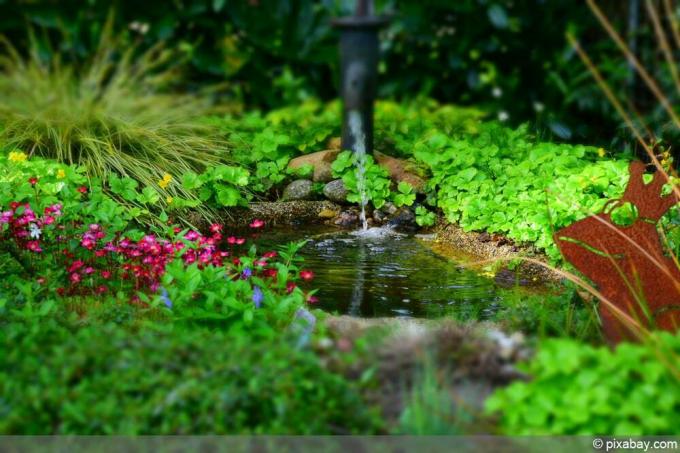
In addition, the depth of a garden pond (but also its volume) determines whether it is suitable for overwintering fish or not. The general rule here is that the smaller the volume and the flatter the pond, the larger it is There is a risk of freezing - and the fish therefore move to winter quarters during the cold season must. A koi pond, for example, must be at least 150 to 200 centimeters deep and contain around 1000 liters of water per fish so that the animals can spend the winter there.
How much space do fish need in the garden pond?
In general, the popular colored carp need a lot of space: juvenile fish, usually no more than 10 centimeters long, initially feel in smaller ponds, but grow to impressive lengths of 70 to 80 centimeters within a few years - and need accordingly Space. You should therefore not adjust the size and volume of the garden pond to the size of the young fish, but to its expected final size. For example, goldfish – which only grow to an average length of around 30 centimeters – require much less space, as do golden orfe, minnows, mustache or veiltails.
Many fish are school animals
However, keep in mind that many of the species mentioned are pronounced shoal animals that only feel comfortable in groups of ten or more fish. Sturgeons, which are particularly popular with lovers of special fish, require a particularly large amount of space. These animals stay mainly at the bottom of the garden pond and can grow between two and three meters in length within a few years. Therefore, a volume of at least 250 cubic meters and a pond size of six by twelve meters is required for each fish.
Formula for calculating the fish stock
You can calculate the ideal fish stock using a simple formula: Plan about half a kilogram of fish per cubic meter of water (ergo 1000 liters). Keep in mind that fish grow quickly and increase in size and weight over the years.
Average sizes and weights for pond fish
- Goldfish: up to 40 centimeters long, up to approx. 2.5 kilograms heavy
- Koi: up to 90 centimeters long, up to approx. 12.5 kilograms heavy
- Minnow (Bitterfish): up to approx. 14 centimeters long, up to approx. 20 grams heavy
- Veil tail: up to 30 centimeters long, up to approx. two kilograms heavy
- Shubunkin: up to 30 centimeters long, up to approx. two kilograms heavy
In addition, the entire volume of water in the pond must not be used for stocking fish. You must reserve the first 1000 liters for the planting, others (depending on the specific floor area) for the stones and gravel-covered ground as well as about 500 to 1000 liters of hidden reserve - for example for the young fish that will inevitably come becomes.
How to calculate the pond volume

In theory, calculating the volume of a pond is very simple, you just have to measure it and then multiply its length, width and depth together. The result is the pond volume in cubic meters, which you can multiply again by a factor of 1000 to get a volume in liters. However, this very simple formula is only suitable for rectangular ponds that slope straight down sidewalls, without any shallow water areas (which would have to be charged extra) and without vegetable or inorganic ones trimming.
Calculate pond volume of irregular ponds
However, since a garden pond rarely has the strictly rectangular shape of a water basin like in a swimming pool, but instead has very irregular dimensions and different water depths, the above formula is only partially suitable for calculating the water volume. Typical garden ponds are measured and calculated as follows:
- Measure the length, depth and width at 50 centimeter intervals.
- This gives you several values from which an average value can be calculated.
- To do this, add up all the values of a quantity and divide the result by the number of measurements.
- Once you have the three required values, multiply them to get the volume.
- Multiplying this again by a factor of 1000 gives the pond volume in liters.
This form of calculation can of course only be an approximation, but not the absolutely correct volume specification.
Sample calculation:
- Three measurements were taken at depth: 0.6 meters + 1.5 meters + 1.2 meters = 3.3 meters
- Average depth of the garden pond: 3.3 meters / 3 measurements = 1.1 meters
The width and length were calculated equally, giving an average width of five meters and an average length of twelve meters.
The number of cubic meters and thus the water content can now be calculated from this: 1.1 meters x 5 meters x 12 meters = 66 cubic meters = 66,000 liters of water.
Tip:
Install a water meter when creating a new pond
So that you not only get an approximate value, but also the correct water content, you can Install a water meter when creating the pond and use this to record the amount of water that has been let in read off. However, here too the number of cubic meters fluctuates over time because, for example, water evaporates, seeps away or is replaced by plant or soil. animal stock is taken up or displaced.
Other factors that influence the pond volume
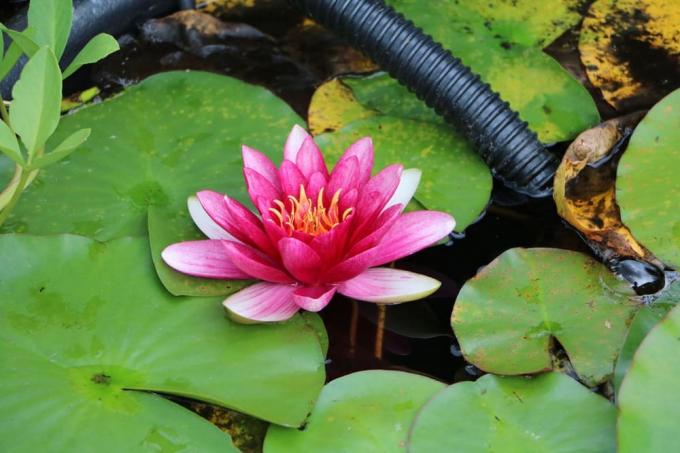
In order for the calculated approximate value to come even closer to the actual one, you must also include factors such as the location, the planting, the thickness of the pond bottom and any (decorative) objects such as larger stones observe. Of course, these must be included in the calculation and thus in the volume specification.
Example
In locations with direct sunlight, the pond plants grow much faster and more luxuriantly than in darker ones. Therefore you increase the calculated pond volume by a quarter for a garden pond in full sun. Referring to the above example, the calculation would look like this:
66 cubic meters x 25 percent / 100 = 16.5 + 66 cubic meters = 82.5 cubic meters
Formula for round ponds
Incidentally, round garden ponds are calculated differently than the classic square or rectangular ones. irregular variants: Here you calculate length x width x depth and multiply the result again by a factor of 2. Only now do you get the pond volume in cubic meters.
Tip:
A stable fish pond contains at least 90 to 100 cubic meters of water and is also suitable for overwintering, larger fish species. When choosing species, keep in mind that not all fish get along well (for example, sturgeon and koi should are not kept together) and also a big jumble of different fish can upset the ecological balance more quickly leaves. Limit yourself to a maximum of two to three species (in larger ponds) or a single species (in smaller ponds).
 garden editorial
garden editorial I write about everything that interests me in my garden.
Learn more about creating a pond

Build your own stream out of concrete 6 tips for investing
If you have a natural stream in your garden, you can count yourself lucky. Such an idyllic facility can also be built from concrete. This guide contains tips for building your own.

Laminate pond | 6 tips for working with GRP
Ponds were and are eye-catchers, animation and variety in many garden designs. They are particularly durable when made of plastic reinforced with glass fiber. However, if you want to process GRP yourself, you should know a few helpful tips in order to skilfully avoid recurring errors and problems.
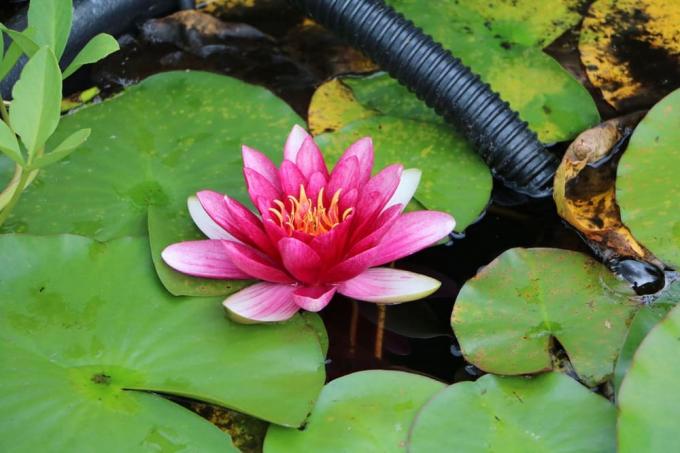
Designing the edge of the pond | 10 ideas for pond borders and pond edge design
If you want to design your pond edge, there are numerous ideas for hiding it. Especially after using pond liner, gardeners rely on a pond border, as this covers the liner and the pond is attractively integrated into the garden.

Build a wooden jetty on the pond yourself - building instructions for a wooden jetty
You have a garden pond and would like to equip it with a jetty? For many it makes sense to leave this project to a professional, but it really is not difficult to build a pond bridge for your garden yourself.

water basin in the garden | An alternative to the pond?
A refreshing highlight in the creative garden design is a magical water world that invites you to linger with its gentle splashing. Creative home gardeners with a penchant for modern solutions rightly ask: are water basins in the garden a sensible alternative to the traditional pond? With practical reflections, this guide would like to help you decide between a water basin or a pond in the garden.
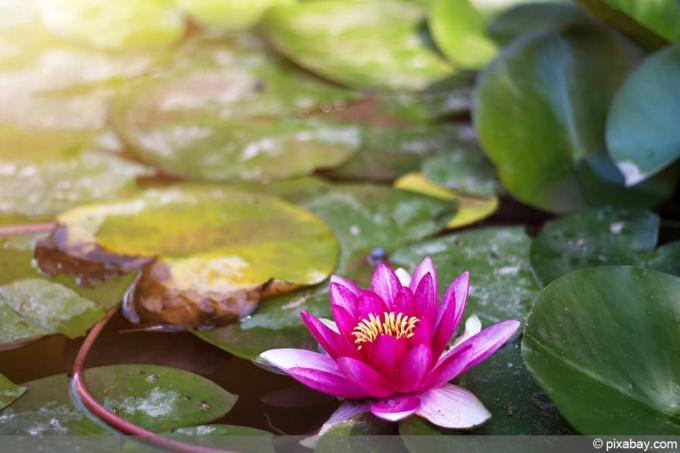
Instructions: Planting the garden pond + 8 beautiful plants for the pond
A garden pond is a very special jewel in every garden. However, in order for it to have an effect, it must be planted. How to do that and which plant grows best where on or in a pond is explained here.


